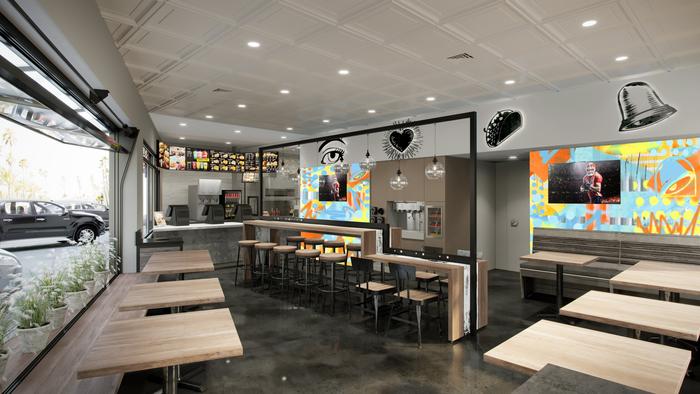
As Taco Bell looks to urban centers for growth, designers like Andrew Nunez are getting free rein to build beautiful new restaurants.
Picture it: You're strolling down Irvine Avenue in Newport Beach, California, when the smell of sea air is suddenly interrupted by a seductive whiff of Mexican-inspired food.
Your nose leads you toward a modern glass building with giant bi-folding doors open to the street. Inside, local artwork pops from the walls. White coffered ceiling tiles, grey concrete floors, and light wood accents make for a distinctly modern vibe. To the side, a 10-foot tall sign reads…Taco Bell?
You're not hallucinating. When it opens later this December, Taco Bell's Newport Beach Cantina will be home to the 13th iteration of Taco Bell's urban-inspired, alcohol-serving, fast-casual restaurant line. Similar Cantinas are already up and running in Chicago, Las Vegas, San Antonio, Cleveland, and other cities. If they sound completely different from the Taco Bells you know, well, that's the point.
Andrew Nunez, a 33-year-old brand architect and designer at Taco Bell, is charged with making sure Cantinas’ aesthetic are on par with the expectations of the savvy city dwellers Taco Bell is trying to lure. At Newport, his fingerprints are all over the design.
Not All Taco Bells Are Created Equal
There are two types of Taco Bells in this world: standard and non-standard.
Standard Taco Bells include the ones you might find in a suburban area where most customers order through the drive-throughs. Non-standard designs are where things get interesting. They include Cantinas and, say, the Colonial-leaning designs you'd find in New England or Adobe-influenced designs in the Southwest, and they require heavy involvement from Taco Bell HQ.
“That's where I start engaging a lot more and using a lot more of my design background and experience to help franchisees figure out what to do," says Andrew, who earned his bachelor's degree in design studies from Arizona State University and grew up near Taco Bell's Irvine, California, headquarters. Merging the aesthetic of the city in which the franchise is located with that of Taco Bell's can be a tall but rewarding order.
“You get very, very granular when you get these nonstandard buildings," he says. “All of us clamor to get the chance to do special stores, just like Newport Beach that's coming up here."
And Then There's Cantina
Cantinas are in a class of their own.
“The regular Taco Bell drive-throughs are geared more toward the convenience of being able to come in and out really quick," explains Andrew. “They're very drive-through and takeout focused. I want to say 70 percent of the business goes through the drive-through."
Cantinas, on the other hand, are restaurants that serve open-plated food and alcohol, which means they have to be appealing destinations where locals want to spend time.
“We like to focus a lot more on what that community is actually telling us to build there," he says. “Not literally telling me, but when I'm walking around, what's the feel of the people that are there? What is the customer really wanting that they might not be getting from the other restaurants that are in that area?"
In Newport, Andrew and the Cantina franchisee are partnering with a local artist, Joe Frizzelle, to deck the walls out with custom artwork. Frizzelle grew up in the area and has designed board shorts for Volcom. Sound like a fit for beach-y Newport?
“Urban customers want to see something new and exciting and feel like it's also connecting to them," Andrew says. “You want to do things that feel natural in these places."
Other notable design elements: a long communal table made from locally reclaimed white-washed wood and modern light fixtures dotted with round glass pendants.
"You want to leave little trophies for people to pick up and find in the design, like routed letters in the reclaimed wood," says Andrew. "What's very urban is the discovery of something new, because in an urban area, there's so much around that there's inspiration everywhere."
Tacos Taking Over
By 2022, Taco Bell plans to open at least 300 Cantina-style restaurants globally. It's one piece of an ambitious international expansion plan that calls for thousands of new restaurants in the next five years. People like Andrew will be a critical part of that effort. But not all projects will be as close to home as Newport.
"When I was 12, I knew I wanted to be an architect," he says. "I told my mom that I was going to build her a Taco Bell in our backyard when I grew up. Then, here we go, I get to build this Taco Bell, and it's a very special one, in the backyard of where I grew up."